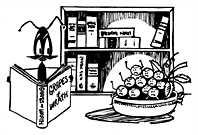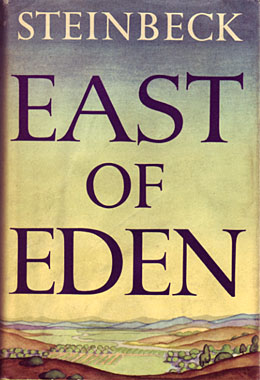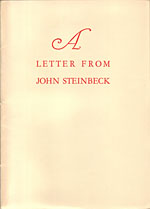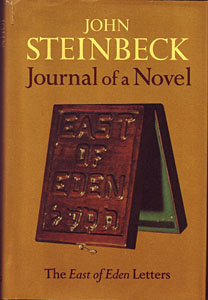Collecting John Steinbeck
This article appeared in Firsts Magazine, January 2007 Volume 17, Number 1.
By James M. Dourgarian
Re-edited & Reformatted for the Web with different images
All Images Copyright 2007 - 2008 James M. Dougarian
View our collection of Steinbeck and Steinbeckiana
CUP OF GOLD
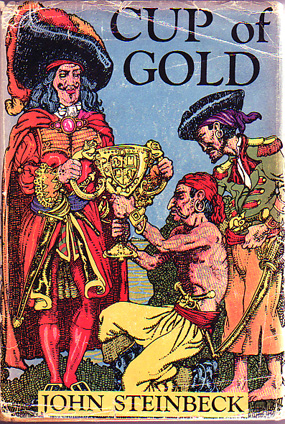 |
Clad in the elusive original dust jacket garishly illustrated by Mahlon Blaine, John Steinbeck's first book, Cup of Gold, is the Holy Grail of any Steinbeck collection. The book was published in 1929 by Robert M. McBride, and had a first print run of only 1,537 copies. Far fewer than that number survives today.
Steinbeck hated that dust jacket, despite the fact that he and Blaine knew each other well. Steinbeck thought the jacket resulted in Cup of Gold being pushed in stores as a juvenile title when he intended the book to be literature. While the author's intentions were good, his results were poor. This historical novel about the Seventeenth century pirate Henry Morgan and his goal of conquering Panama and winning the affection of the fabled beauty known as La Santa Roja is of the purple prose school, and fails to achieve very much, if anything. A paragraph or two may sound like the Steinbeck we know and love today, but it shows little of the brilliance to come.
|
Just about every Cup of Gold dust jacket is now found faded, especially along the spine. It is commonly found chipped at the top and bottom of the spine and at the extremities. Tears to the jacket are all too common. While fine copies of the book with an equally fine jacket do exist, they almost never reach the marketplace. If you ever see one, expect the price to be at least double that of an ordinary copy. These "ordinary" copies, generally in very good condition, command prices between $20,000 and $27,500. Cup of Gold is cited as item A1a in the bible of Steinbeck bibliographies, John Steinbeck: A Bibliographical Catalogue of the Adrian H. Goldstone Collection (hereafter referred to as G&P), compiled by Adrian H. Goldstone and John R. Payne.
Steinbeck collectors, and especially Steinbeck completists, also desire the first edition, second issue of Cup of Gold, as well as other subsequent editions/printings of Steinbeck's early books. This can be confusing for the collector because of poor descriptions by booksellers. Another complicating factor is the marrying of books and dust jackets from different editions or printings, done by both dealers and collectors. These poor descriptions and cross-contamination of dust jackets may confuse bibliographic examinations, but not the facts. Let's examine some of the more important books.
The first edition, second issue of Cup of Gold was published in 1936 by Covici Friede. There is some evidence suggesting there were 939 copies, the sheets left over from the McBride printing. There is other, more recent, evidence suggesting that this was an entirely new printing, bringing whether there were only 939 copies into question. In any event, Covici Friede issued its book with new preliminaries, a preface by Lewis Gannett, a new binding (maroon cloth rather than McBride's yellow cloth), and a new dust jacket, although McBride's colophon remains on the last page of text. Because of a misspelling–"Covici Freide"–the publisher's name is blacked out on the jacket spine with the correct spelling–Covici Friede–printed above. The jacket makes no mention of Steinbeck being the author of Of Mice and Men. Condition equates values. Figure $1,500 to $2,500 for generally very good copies, more for a pristine copy. This book is G&P A1b.
Next in line is the second edition, also published in 1936 by Covici Friede, but without McBride's colophon on the last page of text. The binding is dark blue cloth. The correct dust jacket is similar to its immediate predecessor. It does indicate that Steinbeck is the author of Of Mice and Men, but there is no mention of Covici Friede. This book is valued in the $350 to $500-plus range. The book is cited as G&P A1c.
THE PASTURES OF HEAVEN
 |
Steinbeck's second book, The Pastures of Heaven, definitely has that Steinbeck "sound." The book consists of interrelated stories set in a valley that came to represent Steinbeck Country. In each of the stories, something is not quite right with the inhabitants of this otherwise peaceful valley.
Once again, editions/issues can be confusing and jacket swapping seems rampant. Your best bet is to stick to the facts, as outlined in Goldstone & Payne.
The first edition, first issue of The Pastures of Heaven (G&P A2a) was published in 1932 by Brewer, Warren & Putnam. Although the firm printed 2,500 sets of sheets, only 1,650 copies were bound and only a paltry 650 copies were sold. Once again, far fewer copies exist today. It is a cornerstone book for any Steinbeck collection. Even ordinary copies command $10,000 to $15,000. And once again, think double that for a truly fine copy in a like dust jacket.
|
The remainders (sheets and unsold copies) were sold to publisher Robert O. Ballou. The Ballou first edition, second issue is similar to the first/first, but the spine of the second issue states "Robert Ballou," in spite of the fact that Brewer, Warren & Putnam is shown as the publisher on the title page. The title/copyright page on the first edition, second issue is an integral page, not a cancel. (There has been some speculation that this book, with the integral page is an anomaly, that the copy in Goldstone's collection which now resides at the University of Texas is a one-of-a-kind. There is other evidence to the contrary.) This book is G&P A2b. Its value is generally equal to the first/first.
If you think all this is confusing, be prepared to be bewildered with G&P A2c, the first edition, third issue of The Pastures of Heaven. There are two states. In both cases, Ballou's name appears on the spine of the book and on the title/copyright page, which is a cancel, but "Brewer, Warren & Putnam" still appears on the dust jacket. One state is approximately one-eighth of an inch shorter than the other. Ballou's name appears on the spine of both states in all capital letters, but in one case the "R" and the "B" appear to be larger than the rest of the letters. These would be valued in the $7,500 to $10,000 range, substantially higher if pristine.
Thankfully, the next collectable version of The Pastures of Heaven–G&P A2e, the first edition, fourth issue–lacks confusion. Sheets left over from Ballou were sold to Covici Friede, which published its version of the book in 1935. A new title/copyright page was tipped in. Both the binding and the jacket differ substantially from the earlier issues. Figure $1,500 to $2,500 for value.
TO A GOD UNKNOWN
To A God Unknown was Steinbeck's third published book, although it was written before The Pastures of Heaven. This novel was adapted from a play written by Steinbeck's friend Webster (Toby) Street called The Green Lady. Street was unable to "fix" the play as he wanted, so he gave it to Steinbeck to make it his own.
This he did, moving the setting from Mendocino to his own familiar rural setting. Thus, for the first time, Steinbeck wrote about the interaction of a farm family in a rural setting. It was a move he would not regret. There are times the reader can become lost when Steinbeck becomes "mystical," but his writing is at its rawest and most brutal here. To A God Unknown is a symbolic novel of Joseph Wayne and his family dealing with a fertile land and Wayne's ultimate sacrifice to end a severe drought.
To A God Unknown (G&P A3a) was published in 1933 by Robert O. Ballou. Although Ballou printed 1,498 copies, only 598 were bound and sold. Values range from $7,500 to $15,000, depending on condition. Interestingly, Mahlon Blaine created the vignette on the title page, the endpapers and the dust jacket, all in a more subdued fashion than his work for Cup of Gold.
Covici Friede published the first edition, second issue of To A God Unknown in 1935. Cited as G&P A3b, its title page is a cancel. Both the binding and the dust jacket are quite different from its predecessor. Values range from $1,250 to $2,500 depending on condition. Beware of color photocopy or facsimile dust jackets.
TORTILLA FLAT
Steinbeck's next novel was his breakthrough book. Tortilla Flat (1935) was written while Steinbeck helped care for his ailing mother, and its humor bolstered him during that troubled time. The surface story of Danny and his paisanos and their antics in a poor section of Monterey, California masks a Knights-of-the-Round-Table story. In 1942, M-G-M produced a film version of the book starring Spencer Tracy, Hedy Lamarr and John Garfield, with a wonderful performance by Frank Morgan.
The first edition consisted of 4,000 copies and, unlike the author's earlier books, the entire run sold out. In fact, there were at least eight printings between May 1935 and April 1937. For the first time in his adult life, Steinbeck could support himself as a working writer.
G&P A4a is sewed and wrapped in its dust jacket. There were about 500 of these wrappered books. G&P A4b is the hardcover. Because of the book's popularity, it is difficult to find truly fine copies of Tortilla Flat in like dust jackets. Copies are usually worn, and jacket spines are often well-tanned or well-faded. Lesser copies might be had for $7,500. Better copies command $10,000 or more. Be wary. The rear jacket flap must have the brief biography of Steinbeck, not reviews of the book. Also beware of dust jackets that are steeply price-clipped; this indicates someone was also removing the notation of a later printing.
IN DUBIOUS BATTLE
 |
Steinbeck never liked to follow one book with a similar book. His follow-up to the charming Tortilla Flat was perhaps the greatest strike novel of the Twentieth century, In Dubious Battle (1936). This was his first book dealing with political upheaval, an examination of large California landowners, the Communist Party, and the workers themselves. Because a Communist is a character, it was this book that led many to believe that Steinbeck himself was a Communist or at least a sympathizer. In reality, Steinbeck knew some Communists and consulted them during his research for the book. His ability to soak up information like a sponge was perhaps too good in the minds of some. There would be repercussions later, when Steinbeck tried to become a foreign correspondent during World War Two.
In Dubious Battle was the first of Steinbeck's books to be issued in a signed/limited edition.
|
It also had the smallest print run of all of his signed/limited editions, only 99 copies issued in a tissue dust jacket and housed in a slipcase. Wouldn't you have loved to be first in line in 1936 when it was available at the published price of five dollars? Today, the price ranges from $7,500 to $12,500 and could go higher for a truly exceptional copy.
The first limited edition of In Dubious Battle, from Covici Friede, is cited as G&P A5a. Out-of-series printer copies also exist. The actual number is unknown, and their value is not possible to determine, but it would likely be more than the in-series limited edition. Again, be sure the jacket is tissue, not acetate or clear plastic, which are sometimes substituted.
Covici Friede also released the trade edition of In Dubious Battle (G&P A5b) in 1936. Its value ranges from $3,500 for as very good copy in a like jacket to $5,000 for a fine jacketed copy.
SAINT KATY THE VIRGIN
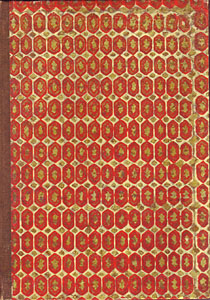 |
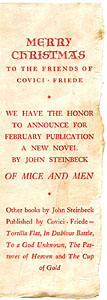 |
Saint Katy the Virgin (1936, G&P A6a) had a limited release only. The book was issued in an edition limited to 199 copies signed by Steinbeck. Board in patterned boards with gilt cloth spine and issued with a clear plastic dust jacket, the book was a Christmas gift for friends of the author and his publisher, Covici Friede, with a small Christmas slip loosely laid in that also advertises the upcoming Of Mice and Men. The Saint Katy story, which is about a pig, was later included in Steinbeck's The Long Valley.
|
The book has an interesting history in regard to value. Years ago, perhaps before most collectors had "discovered" it, the book was valued between $1,750 and $2,500. The higher price had to include the dust jacket and the Christmas slip. Despite ensuing years and a very small print run, its value today is essentially the same. Condition is an issue, as this is a fragile book.
OF MICE AND MEN
Although Tortilla Flat was Steinbeck's first popular book, Of Mice and Men (1937) was his first classic, his first work of true literature. This short novel later became a Broadway play, was adapted for the opera, and served as the basis for both television and theatrical films. (It was, in fact, Steinbeck's first book to be made into a film.)
Of Mice and Men is the tragic story of two drifters. Lennie has a huge, powerful body and a tiny brain. George looks after Lennie, protecting him as they seek their shared dream of living off the fat of the land. The two men must rely on each other as they attempt to live in a world divided into the powerful and the powerless.
There were 2,500 copies of the first edition, first issue of Of Mice and Men (G&P A7a). There are issue points for this book. The first issue has what looks like a bullet between the eights on page 88. Also, on page nine, lines 20 and 21 read "and only moved because the heavy hands were pendula." These nine words, an awkward bit of phrasing, along with the bullet on page 88, were removed from subsequent printings. Perhaps the book's most common flaw is tanning of the jacket spine. Beautiful copies can command as much as $5,000. Lesser copies bring substantially less, in the $2,000 to $3,500 range.
Did you know that Steinbeck's dog ate the first manuscript for this important novel? It's true. Imagine telling that to your publisher. Faced with this crisis, Steinbeck simply sat down and rewrote the book, an astounding feat.
There is also a first edition, second issue of Of Mice and Men, but beware! The first edition, second issue, recorded as G&P A7b, looks very much like the book club edition. In fact, a substantial number of copies are offered as first editions that are actually book club editions with the top front flap of the dust jacket clipped as if it were price-clipped when, in fact, there was never a price there. It is not too big a stretch to say that virtually all copies offered in the marketplace without a price on the front flap or with that section clipped away are indeed book club editions, although most of these are priced as if they are the real McCoy. They are not. Interested parties should consult the February 2003 issue of Firsts for Andrew Halldorson's definitive article on this specific subject. G&P A7b, the real McCoy with a price on the jacket, is perhaps even scarcer than the first issue. A number of well-known Steinbeck specialists will tell you that they haven't seen one in years. While book club editions being sold as if they were G&P A7b are available, the real deal is not. Its value should be nearly that of G&P A7a.
The play version of Of Mice and Men (G&P A8a) followed the novel. Covici Friede also published it, also in 1937. Fine copies should bring $2,500, probably more. Very good copies can be had for $1,000 to $2,000.
THE RED PONY
Next in line of publication was the limited edition of The Red Pony (1937, G&P A9a), consisting of 699 copies signed by Steinbeck. This limited edition was issued in a glassine dust jacket in the publisher's slipcase. It is difficult today to find copies with the glassine jacket, and even more difficult to find the book, jacket and the slipcase all in fine condition.
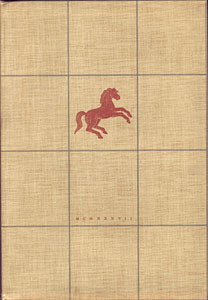 |
Published by Covici Friede, The Red Pony consisted of four related short stories, each of which had appeared earlier in periodicals: "The Gift," "The Great Mountains," "The Promise" and "The Leader of the People." The book was originally published at $10, which was a lot of money in those Depression era days. Even so, it sold out. It contains elements of Steinbeck's boyhood, including the red pony he was given as a child. The book calls for the reader to see the story through the boy's eyes. Steinbeck would use this sort of participatory reading technique again, both in The Grapes of Wrath and East of Eden.
The first illustrated edition of The Red Pony (G&P A9c) appeared in 1945 with color illustrations by Wesley Dennis.
|
| G&P records three states of this edition. There actually are four. There is no apparent priority, although G&P indicates that A9c was printed by Kipe Offset Process Company, bound in a coarse beige cloth, housed in a blue-gray slipcase. It reports that Variant One was printed by Zeese-Wilkinson Company, bound in a fine beige cloth, also housed in a blue-gray slipcase, while Variant Two was printed by Rogers-Kellogg-Stillson and also bound in a fine beige cloth, but housed in a tan slipcase. The unrecorded fourth variant was also printed by Zeese-Wilkinson, but was bound in a fine light tan cloth and housed in a tan slipcase. All of the illustrated editions are easily found and range in price from $75 to as much as $250. The signed/limited edition, in the condition usually found today, ranges from $2,500 to $3,500, but would be substantially more for fine copies. |
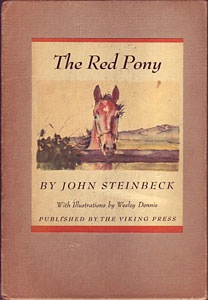
|
There were also 52 lettered copies within the limited edition, also signed by Steinbeck. These would be lettered A, AA, B, BB, etc. Value is difficult to determine, but it is likely to be along the same lines as the numbered limited edition, although they might achieve a higher dollar value.
THEIR BLOOD IS STRONG
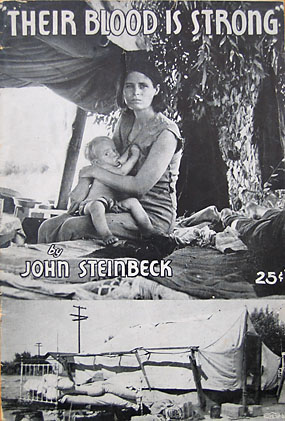 |
The late 1930s was both a provocative time in Steinbeck's life and a fertile time for his writing. It was during this time that he traveled to the southern part of California's Great Central Valley to research conditions suffered by migrant farm workers, especially those who came from Oklahoma's Dust Bowl. This work led directly to publication of A10a, Their Blood Is Strong (1938), a little pamphlet that originally sold for 25 cents. The material in this book was published originally as a series of articles in the October 5-10 and October 12, 1936 issues of The San Francisco News. That series, entitled "The Harvest Gypsies," was then given to Helen Hosmer, head of the Simon J. Lubin Society, which published the retitled pamphlet and channeled the proceeds to help migrant workers. For Their Blood Is Strong, Steinbeck added an eighth piece entitled "Starvation under the Orange Trees" which served as an epilogue.
|
This very elusive Steinbeck title has the famous front cover photo by Dorthea Lange of a mother suckling her child. The importance of Steinbeck's research, publication of the newspaper series, and publication of Their Blood Is Strong cannot be overstated, as all contributed to the writing of his masterpiece, The Grapes of Wrath. There were four issues of Their Blood Is Strong, all published in 1938. First issues bring $1,250 to $2,000, perhaps higher for truly fine copies. Signed copies of any of the first four issues are extremely rare.
THE LONG VALLEY
The year 1938 marked the first publication of a Steinbeck book by his new publisher. Covici Friede had failed as a business, but Pascal (Pat) Covici survived and moved to The Viking Press. Covici took Steinbeck with him, and remained his editor at Viking. The Long Valley (1938, G&P A11a) was Steinbeck's first book for Viking.
The Long Valley is an undervalued book, both dollar-wise and critically. Steinbeck was a master of the short story, especially in this early part of his career, and The Long Valley includes some of his best work, showing Steinbeck at the height of his literary powers. Included in the book is "The Chrysanthemums," perhaps his most anthologized short story. It is a gem, as is just about every other story Steinbeck wrote: "The White Quail," "Flight," "The Snake," "Breakfast," "The Raid," "The Harness," "The Vigilante," "Johnny Bear," "The Murder," and all four stories that comprise The Red Pony, plus "Saint Katy the Virgin," which had been previously published separately as a signed/limited edition.
The dust jacket for The Long Valley was illustrated by Elmer Hader, who would also illustrate the dust jacket for The Grapes of Wrath and, much later, the dust jacket for The Winter of Our Discontent. While the print run was 8,000 copies–substantially higher than any of his previous books–that number is dwarfed by the print runs of the books that followed. Very good or better copies run $1,000 to $2,000, while fine copies in like jackets should bring $3,000 or more.
THE GRAPES OF WRATH
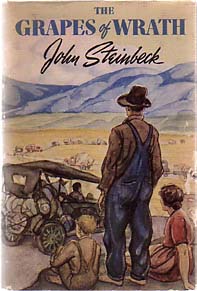 |
What is your pick for The Great American Novel? Not everyone would vote for The Grapes of Wrath (1939) as Number One, but this masterpiece undoubtedly makes everyone's list.
Did you know that the published version was Steinbeck's third attempt to make sense in writing about what he found happening to migrant farm workers in California's Great Central Valley? He first wrote a book called The Oklahomans. The attempt was a failure, and he knew it. He destroyed the manuscript. He then wrote a 70,000-word, hate-filled satire he called L'Affaire Lettuceberg. Steinbeck said his father would have called it a "smart aleck book," and it might well have been successful.
|
But Steinbeck needed to vent his feelings, to rid his mind of certain poisons before the work would flow and he could achieve what he called that warm, curious feeling he got when his work went well. Viking had actually announced the book before Steinbeck destroyed it and started over again.
His creativity could hardly have been more acute, or more focused. He wrote the 600-plus pages of his most famous book in a sustained burst between June and October 1938. The Grapes of Wrath is both a plea for understanding and an indictment of a system that promotes two classes, the very rich and the very poor. Many of those in his closest circle in the publishing world were terribly concerned about the book's controversial ending, but could there be a better ending to tie together the loose ends of what is essentially a plotless book? Steinbeck stood his artistic ground and won, and he was right.
The Grapes of Wrath won the Pulitzer Prize for fiction and was made into a classic John Ford film starring Henry Fonda in an amazing performance as Tom Joad, and Jane Darwell, who won an Academy Award for her spot-on performance as Ma Joad.
Collectors today are sufficiently sophisticated to know that The Grapes of Wrath (G&P A12a) can generally be identified by the "FIRST EDITION" statement on a tab on the lower portion of the front dust jacket flap. Even if the dust jacket is price-clipped on the upper corner, collectors know that this jacket is correct if that tab in intact. The print run for The Grapes of Wrath was 50,000 copies, so today it is not a scarce book. As always, condition is a strong determining factor in value. Very ordinary, somewhat tired copies of the first edition can generally be had for $2,500. A fine copy might be four times that value. A very fine copy–crisp, bright, colorful, clean and unflawed–might command even more.
There were a number of significant subsequent editions of The Grapes of Wrath. The Limited Editions Club produced a two-volume set illustrated by Thomas Hart Benton in 1940. It is easy to find in its slipcase, but is much more difficult to find with the glassine dust jackets intact. Value is generally between $750 and $1,250. The Canadian edition looks very much like the American first, and is much more scarce. Value is in the $2,000 to $3,000 range. World Books of London produced an edition in 1940 whose dust jacket has cameo-like photos of the stars of the film version of The Grapes of Wrath presented in a horseshoe layout. Figure $300 to $450. G&P records only the second Armed Services Editions issue, which is No. 690 produced in 1945. The first ASE issue was No. C-90, a D-Day (1944) issue and very difficult to find. Think $200 to $300.
JOHN STEINBECK REPLIES
John Steinbeck Replies (G&P A13a) is an odd little book, just a single sheet folded to make four pages. It was published by L. M. Birkhead, national director of the Friends of Democracy, in 1940. Birkhead had written to Steinbeck asking him to respond to allegations that Steinbeck was a Jew and that his book The Grapes of Wrath was Jewish propaganda. Birkhead's letter is produced in this little throw-away, followed by Steinbeck's reply. A truly fine copy of this fragile item should bring about $1,500, less for a lesser copy.
The book was also published in 1940 by the Overbrook Press of Stamford, Connecticut, as a small hardcover with a glassine dust jacket, in a limited edition of 350 copies. It carries a very long title of A Letter Written in Reply to a Request for a Statement about His Ancestry. It, too, is a fragile volume, and difficult to find with the glassine jacket. Figure close to $1,000 for a fine copy, and $500 to $750 for a very good copy.
THE FORGOTTEN VILLAGE
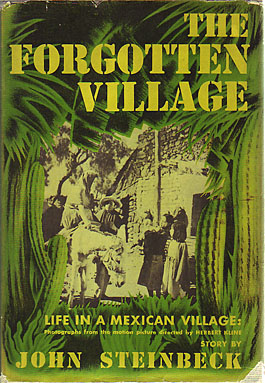 |
The Forgotten Village (G&P A14a) was published by Viking in 1941. It traces daily life in a Mexican village. Steinbeck provided his own preface. His commentary provides the story of the book, and is accompanied by 136 black and white photographs by Rosa Harvan Kline and Alexander Hackensmid from the Herb Kline-directed documentary film of the same name.
The coarse buckram binding of The Forgotten Village is often darkened from binder's glue, especially along the spine. It is not a difficult book to find, although fine copies are scarce. A Book League issue followed, and "second printing before publication" copies also seem to be abundant, though not terribly valuable. A fine copy in a like jacket of the first edition should bring $500 or possibly more. Very good copies can be had for about $150.
|
SEA OF CORTEZ and THE LOG FROM THE SEA OF CORTEZ
Steinbeck's next major offering was completely different from any book he had previously produced. Sea of Cortez (1941), co-authored by Edward F. Ricketts, is a book of marine biology that is still highly regarded by marine biologists.
Ricketts was Steinbeck's best friend. He had already appeared as a character in In Dubious Battle and in "The Snake," one of the short stories in The Long Valley. He made a major appearance later, as Doc in Cannery Row and Sweet Thursday, and as Lee in East Of Eden.
Steinbeck, his first wife, Carol, Ricketts, and a small crew sailed to the Sea of Cortez to collect marine specimens. Steinbeck wrote most of the log, while Ricketts wrote the scientific appendix, which includes beautiful color plate illustrations. Not only is the book an account of how marine invertebrates are preserved and classified, but it is also an explanation of Steinbeck's personal life philosophy.
There was an advance issue in brown wrappers, cited by G&P as A15a. It prints only half of the text, omitting the scientific appendix. Its value is in the $2,000 to $2,500 range. The first trade edition (G&P A15b), a hardcover with dust jacket, was published in 1941.
The book was published in 1951 without the scientific material as The Log from the Sea of Cortez (G&P A15c). That book was an homage to Ed Ricketts, who had died in a car-versus-train accident. The Log from the Sea of Cortez includes Steinbeck's 67-page tribute, "About Ed Ricketts."
Dust jackets don't mean much to marine biologists, who might also make notes in their books and hold them in one hand while peering into a tide pool. Thus, condition is always an issue. Unjacketed copies of Sea of Cortez can bring $200. Very good copies in jacket range from $450 to $750. Really fine copies go for $1,250 and more. The Log's dust jacket is typically found faded along the spine, although the book itself holds up well. Such typical copies run $300 to $450. Copies without fading are rare, as are copies without a few nicks, tears and chips at the extremities. An unfaded copy without these flaws should sell for $750, and probably more.
There is a binding variant for The Log. The majority of copies are bound in maroon cloth. Some are bound in a turquoise cloth. Value should be the same.
THE MOON IS DOWN
The Moon Is Down (1942) was Steinbeck's first novel after the publication of The Grapes of Wrath. It is a novel of World War Two, and describes the occupation of an unnamed town by an unidentified Army, although it is fairly easy to discern that it is set in Norway during its occupation by the Nazis. The Moon Is Down made Steinbeck a hero in Scandinavian countries. Possession of a copy in occupied Europe was a death sentence.
The Moon Is Down was the author's second experiment in writing a book whose dialogue could essentially be lifted and made into a play. (The first was Of Mice and Men.) Critics savaged Steinbeck for not having written another novel with the power and artistry of The Grapes of Wrath, or another Of Mice and Men, or another book set in Steinbeck Country. This galled Steinbeck, who disliked the notion that he had to write the same book over and over again, or that all his books had to be masterpieces.
A wrapper-bound edition of 700 copies of The Moon Is Down (G&P A16a) was produced for review, with the binding sewn and wrapped in the dust jacket. Very good copies bring $350 to $500-plus while fine copies should bring $750. There were 65,000 copies printed of the trade of The Moon Is Down (G&P A16b), making it all too common today. There are two issues of the ubiquitous trade edition, but be careful. A lot of dust jacket swapping appears to have taken place among the many available copies of this book. The first issue of the first trade edition has a dot between the words "talk" and "this" on line 11 of page 112. The first issue dust jacket is textured. In the second issue, the dot is removed and the dust jacket is smooth. The book was well read, so finding beautiful copies is difficult. A beautiful copy of the first trade edition, first issue should bring $250 or more. The second issue should sell for much less, simply because there was so many copies of the book available and because it is rated lower on the desirability scale by collectors.
The play version of The Moon Is Down (G&P A17a) is another matter. It is comprised of two states. The acting edition, issued by the Dramatists Play Service in 1942, is one of 1,250 copies, with 1,000 being bound in stiff yellow wrappers that bulk to 12 mm. The Dramatist Play Service had a second printing, also bound in stiff yellow wrappers. It is identical to the first except that its sheets bulk to 8 mm. Both are collectable, but the first is more desirable and more valuable. It should sell for around $350 to $500, depending on condition. The second issue should be valued at half those figures.
The most desirable copy of the play is G&P A17b. The Dramatist Play Service gave 250 sets of its sheets to Viking, which issued a hardcover version with a dust jacket and a reprinted title page. These hardcovers are extremely difficult to find. Value is $2,000 to $2,500-plus, with condition always being a determining factor. Curiously, there was also a second Viking hardcover edition. It is odd that such a book would have been produced; the second printing is not recorded by G&P.
BOMBS AWAY
While Steinbeck had great difficulty trying to become a war correspondent during World War Two because of previous hints at his possible Communist leanings, the Army had no trouble enlisting his help to write a book of propaganda during the war. Viking published that book in 1942. Bombs Away: The Story of a Bomber Team (G&P A18a) follows six young men through several training assignments on their way to deployment as airmen. The volume is illustrated with 60 black-and-white photos by John Swope, and the dust jacket is designed by Arthur Hawkins Jr.. Very good copies run between $150 and $250. Fine copies are difficult to find. Figure two or three times the value of a very good copy.
Harper & Brothers produced a hardcover school edition without dust jacket of Bombs Away in 1942. This book is not recorded by G&P. While its value is generally around $250, it is a difficult book to sell.
Be careful when looking at a copy of Bombs Away. Few collectors and few booksellers know this, but there were also second and third printings. The books themselves are identical to the first printings, but the rear dust jacket panel will state "second printing" or "third printing."
THE VIKING PORTABLE LIBRARY STEINBECK
At this point in his career, Steinbeck was an extremely poplar and best-selling author. Thus, in 1943 Viking produced the first of its Steinbeck compilation books, The Viking Portable Library Steinbeck (G&P A19a), a small hardcover with dust jacket. (See "Fifty Years of Viking Portables" in the September 1992 issue of Firsts for more about the Viking Portable series.)
The volume includes selections from The Long Valley, The Pastures of Heaven, Tortilla Flat, In Dubious Battle, Of Mice and Men, The Red Pony, The Grapes of Wrath, Sea of Cortez, The Moon Is Down and Bombs Away. The selections were made by Steinbeck's friend and long-time editor, the legendary Pascal Covici. This was a popular book in a popular and collectable series. Thus, finding fine copies in like jackets can be difficult. A fine copy might bring $250; very good copies in like jackets command $75 to $125.
"HOW EDITH McGILLCUDDY MET R.L.S."
Steinbeck's regular publisher, The Viking Press, was not the only entity that wanted a portion of the Steinbeck gravy train. In 1943 The Rowfant Club of Cleveland, Ohio published Steinbeck's short story "How Edith McGillcuddy Met R. L. S." (G&P A20a) in its first separate hardcover edition. This is a thin folio volume, one of 152 copies printed by The Grabhorn Press. Bound in decorative boards with a black cloth spine, it was issued in a plain green paper dust jacket that carries the same number in manuscript as the limitation number of the book.
This charming little story was first published in the August 1941 issue of Harper's Magazine. It originated from the mother of two of Steinbeck's boyhood friends from Salinas, Jack and Max Wagner. Edith Wagner, nee McGillcuddy, had actually met Robert Louis Stevenson in Monterey, California in her youth. Steinbeck had heard this story, of course, and eventually made it his own.
The value of the book today is about $2,000 or more, but perfectionists beware! The green paper dust jacket was not the highest quality paper available. The books may well be fine, but don't hold your breath looking for a fine jacket. Virtually all dust jackets today are flawed–faded, discolored, torn, chipped, and, in general, ugly.
THE STEINBECK POCKET BOOK
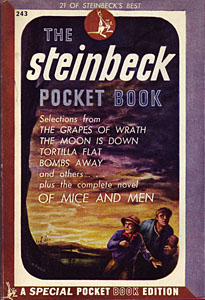 |
That same year, 1943, Pocket Books got into the act, although in a much more pedestrian manner, publishing The Steinbeck Pocket Book (G&P A21a). This paperback original includes all of Of Mice and Men, plus selections from The Grapes of Wrath, The Moon Is Down, Tortilla Flat, Bombs Away, The Long Valley, The Pastures of Heaven and Sea of Cortez, all selected by Pascal Covici. The book had at least three printings, each of which is easily identifiable. The first printing states "first printing" and has no additional statements about printings. The second printing shows the month and year for both the first and second printings without any additional statements about printings. Likewise, the third printing shows the month and year for all three printings without additional statements about printings. Copies of the first are not difficult to find, and are valued at $35 to $50.
|
CANNERY ROW
In 1945, World War Two was winding down, and so was Steinbeck's second marriage. Death was on his mind–the deaths of so many soldiers and civilians in the war, and the death of his relationship. The good days of the late 1930s were gone. Critics wondered why he didn't write the same book over and over again or harped on the fact that not every book was a powerhouse.
Out of this mindset came a small book, a minor masterpiece that in reality is not so minor. Cannery Row was published in 1945. While its surface story is humorous, the humor masks its true themes of death and loneliness. The book is set in Monterey, in Ed Ricketts' marine biology lab, which Steinbeck knew so well. There are parties, to be sure, and good fun, but in the midst of both fun and parties there are deaths, suicide and loneliness. Steinbeck biographer Jackson J. Benson called Cannery Row Steinbeck's war novel, although Steinbeck never mentions the war in it.
An advanced state of Cannery Row was issued in blue wrappers, very probably for review. Cited as G&P A22a, its value is generally around $750 in very good condition, probably more for a pristine copy. The hardcover edition with dust jacket illustrated by the famed Arthur Hawkins Jr. exists in two states. G&P A22b was originally bound in light buff cloth. Because there wasn't enough cloth to finish the run, a bright canary yellow cloth was used on the remaining copies. The light buff copies are preferred and carry a higher value, $1,500 to $2,500. The canary yellow copies might be had for as little as $250, but these would be for ordinary copies. Pristine copies should bring $750 or more.
THE WAYWARD BUS
Steinbeck's next book was another novel, The Wayward Bus (1947, G&P A23a), about a group of strangers who are stranded on a bus. In the beginning of the book Steinbeck's writing is so clear, so realistic you would swear you were inside the bus stop's coffee shop. Unfortunately, the reader can become lost in the last part of the book, when Steinbeck's writing becomes too allegorical. Although critically it is an undervalued book, Viking printed 100,000 copies of The Wayward Bus, and Book-of-the-Month Club editions are everywhere. The Viking first was issued in "dark reddish-orange cloth," according to G&P, which also notes two binding variants: one "browner than" and one "pinker than" the original dark reddish-orange cloth. The first editions and book club editions all look remarkably similar (the B-O-M-C edition has the "dreaded dot" embossed on its back board) and once again, dust jacket swapping is rampant. Make sure you consult your bibliography. A fine copy in a fine jacket might bring $250 or more, but the value for lesser copies should plunge considerably because of over-abundance.
VANDERBILT CLINIC
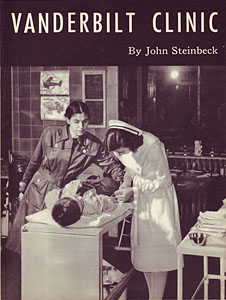 |
Steinbeck's next book was not a commercial venture. Published in 1947, Vanderbilt Clinic (G&P A24a) was the third in a series of reports on this clinic at New York's Presbyterian Hospital. Steinbeck wrote it because the hospital had served him and his family well over the years.
This is a very scarce volume. Not even the hospital has a copy; someone stole it. It can be a difficult book to sell because of the modern inclination to buy only high spots, which in Steinbeck's case means major novels, not obscure pamphlets. Unlike the author's novels, which often suffer condition-wise from repeated readings, this book is usually found in very nice shape. Figure $750 to $950.
|
THE PEARL
The author's next book is one of his most popular; one that readers point to as being the book that first introduced them to John Steinbeck and made them want to read more of his work. The Pearl (1947, G&P A25a) is a parable about a poor pearl fisherman who finds a large, perfect pearl that brings him only sorrow. The book was illustrated by Jose Clemente Orozco.
The first issue dust jacket has a photo of Steinbeck on the rear panel in which he is looking to his left. The second issue jacket has him looking to his right.
Once again, condition is an issue. While this is generally true for all authors, it is especially true for popular authors and their most popular books because they were read so much. Firsts with first issue jackets command $350 to $450 for very good to fine copies, much more for copies in pristine condition. Firsts with second issue jackets can be purchased for as little as $125.
THE FIRST WATCH
The First Watch (1947, G&P A26) was another noncommercial venture from Steinbeck, and an expensive one! It prints a letter dated January 5, 1938 from the author to Arnold Gingrich, who had given him his first watch as a gift.
| Gingrich, who was the editor of Esquire magazine and had recently published some of Steinbeck's short stories, is referred to only as "Mr. G" in the text.
The letter is full of typical Steinbeck humor. "My time sense was so utterly undeveloped that I rarely got to school on time and sometimes left the school long before it was dismissed." He writes that he had expected a watch as a gift when he graduated from the eighth grade, but instead received a signet ring. He hoped for a watch when he graduated from high school, but instead he received a pen and pencil set. He attended Stanford University, but he never graduated. Thus, no watch! It is unclear why Gingrich gave Steinbeck the watch, but possibly scenarios are fun to consider.
|
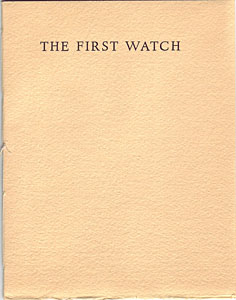
|
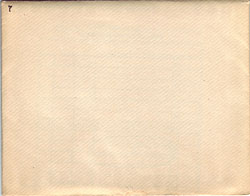 |
Only 60 copies of The First Watch were produced in 1947 by Marguerite and Henry Louis Cohn of the House of Books in New York for presentation to friends. The book was printed by the Ward Ritchie Press and bound in buff wrappers with hand-ties. The first 10 copies, numbered 1 through 10, were reserved for Steinbeck. Each of the physically slight books was housed in a plain white envelope carrying a number in manuscript corresponding to the enclosed book's limitation number, which is also in manuscript.
|
Any of the Steinbeck copies would carry a premium in price, especially if the envelope were present, although most copies today lack the envelope. Such copies with all the original components should bring $10,000. The price would drop, but not by much, for copies without the envelope. For copies numbered 11 through 60, the price can range from $4,500 to $8,500, depending on condition and whether the envelope is present. There were an unspecified number of unnumbered, out-of-series copies. They should bring less. It should also be noted that there are significant differences in the letter produced as The First Watch and the letter as reprinted on pages 151-152 of Steinbeck: A Life in Letters (Viking, 1975).
A RUSSIAN JOURNAL
Steinbeck was always a restless man who loved to travel. He combined his nervous energy and passion for travel with his artistic abilities to produce a large body of journalism. A trip he took to Russia produced a number of reports published in various newspapers, which, along with other, unpublished material, were published in 1948 as A Russian Journal (G&P A27a). The book was illustrated with photographs by one of the most notable photographers of his day, Robert Capa. In fact, Capa also wrote one of the chapters, a rather humorous piece that concentrates on Steinbeck's prodigious thirst for liquor.
A Russian Journal is found in four different bindings. Goldstone & Payne lists them in order of scarcity, but indicates there is no known priority. The bindings are: 1) Grayish-green cloth with light grayish-yellowish brown spine; 2) grayish-green cloth and a grayish-yellow spine; 3) grayish-green cloth with a moderately yellow spine; and 4) light bluish-green cloth with a moderately yellow spine. Collectors will need a color chart to tell which version they have.
One might think that a book such as this–-not a novel–would not be well read and thus readily available in fine condition. Well, the books are generally fine, but the jackets are not. As always, condition equals price. Common copies, depending on the scarcity of the binding, should bring $150 to $250. Jacketed copies in fine condition bring $450.
FOREWORD TO "BETWEEN PACIFIC TIDES"
Good luck finding this book in any condition. Depending on whom you rely for information, there were either 10 or 25 copies of this volume. In either event, Foreword to "Between Pacific Tides" (1948, G&P A28) is missing from most Steinbeck collections, public or private.
This wrapper-bound book separately prints the foreword Steinbeck wrote for the revised edition of the Jack Calvin/Ed Ricketts book, Between Pacific Tides, a highly sought-after book of marine biology. That book was first published in 1939 and didn't include Steinbeck's foreword. The book has been revised many times since, but the first time was in 1948, when it was released as a hardcover with dust jacket that included Steinbeck's foreword for the first time.
That foreword subsequently was separately printed and instantly became a great rarity. A copy in the 1970s sold for $10,000. In 1980, Bradford Morrow's historic catalogue of the Harry Valentine collection of Steinbeck listed a copy for a paltry $4,500. Collectors should buy every copy of Foreword to "Between Pacific Tides" they can find at that price. Its value today is a guess. Think $25,000 to $35,000.
BURNING BRIGHT
Published by Viking in 1950, Burning Bright (G&P A29a)) was the last of Steinbeck's novel/play experiments. It was also the least understood and least successful. The story of a sterile man who must accept another man's child as his own, this play-in-story-form isn't difficult to find. If you did manage a copy with a dust jacket bearing its original title, In the Forests of the Night, you'd have cause to celebrate! Many of the Burning Bright dust jackets suffer from fading along the spine. These might be had for as little as $125. Fine copies bring $350.
THE SHORT NOVELS OF JOHN STEINBECK
The Short Novels of John Steinbeck (1953, G&P A30a) is another compilation. It includes Tortilla Flat, The Red Pony, Of Mice and Men, The Moon Is Down, Cannery Row and The Pearl. The volume is not difficult to find, but be careful. Its publication date, 1953, must appear on the title page. Many copies offered as firsts are not. This apparently was a popular book, as most copies seem worn and a little tired. Very good copies run about $125. Think $350 or more for fine copies.
VIVA ZAPATA!
The next book is a ghost. When most Steinbeck collectors think of Viva Zapata!, they think of the Viking Compass production of 1975, a wrapper-bound volume containing Steinbeck's Academy Award-nominated screenplay. But the screenplay was first published in 1953 in Rome by Edizione Filmcritia, with an introduction by Giovanni Calendoli. Cited as G&P A31, it was a paperbound book issued with a dust jacket. It has one woodblock illustration and was priced at 600 lire.
Viva Zapata! tells the story of Emiliano Zapata, champion of peasants during the Mexican Revolution. Collectors should buy every copy they see, but therein lies the problem: You'll probably never see one. Adrian Goldstone obviously had a copy, since he was able to describe it in the bibliography. Everyone else had been pursuing a copy for decades, without any luck. A copy owned by a very long-time Steinbeck collector whose collection is being dispersed was sold recently. Steinbeck specialists will tell you this copy was the first and only copy they know of; even most of the experts never have seen one. That copy brought $2,500, but it's reasonable to think $3,500 or more, for just about any copy in any condition. Many Steinbeck scholars believe the author's work on this script was his best since The Grapes of Wrath.
EAST OF EDEN
|
|
The 1930s were very good to Steinbeck. The 1940s were a little spotty. In the early 1950s he married his third wife, Elaine Scottt, the love of his life. It was at this time that Steinbeck wanted to set down the story of his family's history for his two young boys, Thom and John. The result was a flawed masterpiece, the novel East of Eden (1952).
The book is badly in need of an editor's blue pencil. It contains tiny chapters that simply do not belong in the book. One is a hilarious story, about Steinbeck's mother taking an airplane ride, that begs for a separate printing. One chapter that was separately printed is Chapter 34. Chapter thirty-four from the novel East of Eden was separately printed by Valenti Angelo in 1952 in an edition of 125 copies bound in limp buff wrappers.
|
It is a brief and powerful chapter that states there is only one story to be told, that of the battle between good and evil. The writing is beautiful and meaningful, but the chapter had no business being included in the book.
The first one-third of East of Eden is ponderous, serving mostly as a history or set-up for what follows. Once the reader gets past that stage, the story flows rapidly. The various story levels reveal themselves and the reader is enthralled. Once again, Steinbeck's late friend Ed Ricketts becomes a character. The discussions and by-play between family patriarch Sam Hamilton and his manservant, Lee (Ricketts), are simply beautiful. Although Steinbeck intended this to be his family story, it became more, as novels often do. It took on a life of its own, becoming a Cain and Abel story that questions whether man is predestined to be as he is, or has free will and the ability to change. East of Eden is the "big" book that Steinbeck had planned to write all his life. At times it is perfect; at other times slow; at still others, mystifying. For all its strengths and weaknesses, in the end it is still a masterpiece.
Viking seems to have noticed the book's importance. It released East of Eden in a signed/limited edition of 1,500 copies with a clear plastic dust jacket housed in a slipcase with a wood grain pattern. G&P A32a was published at $12, which was a lot of money in the early 1950s. What a bargain it seems now! A large number of surviving copies have lost their dust jackets. A number of others are missing the slipcase. Value today runs between $2,500 and $4,500, depending on condition and how many of the original components remain. Superior copies might bring considerably more.
The trade edition, G&P A32b, had a print run of 110,000 copies. The first issue jacket has a photo of Steinbeck on the rear jacket panel looking a little like Tennessee Williams. Later issue jackets carry reviews of the book. Some would say there is an issue point–"bite" instead of "bight"" on line 38 of page 281–but this is a red herring. That error appeared in every copy of the book printed until some time in 1956, including reprints by other publishers. Like The Grapes of Wrath, East of Eden is not a scarce book, but finding superior copies can be a chore. Very good copies run $400 to $750. Fine copies run $1,250 and up, and very fine copies fetch prices in the $2,000 range.
SWEET THURSDAY
Sweet Thursday (1954) is a funny little book. It is essentially a sequel to Cannery Row, but has none of the literary designs of its predecessor. Instead, it is a much more light-hearted love story.
Goldstone & Payne indicates that A33a was issued in wrappers with a Paul Galdone dust jacket wrapped around them, but no one seems to have ever seen a copy. G&P A33b is the trade edition. Steinbeck's photo by Philippe Halsman dominates the rear jacket panel of the first issue dust jacket. There is a second issue jacket not recorded by G&P, which carries a much smaller photo of Steinbeck and reviews of the book. This jacket is very much like the book club edition, but it includes a price, $3.50, which the book club edition does not.
Rodgers and Hammerstein adapted the book into a Broadway musical play called Pipe Dream, which Viking published in 1956 (G&P notes the volume as A33j).
The value of G&P A33a is a guess, probably around $1,500. The trade edition (G&P A33b) can bring $200 to $450. The price for a collectable copy of Pipe Dream is essentially the same.
POSITANO
Positano, a pamphlet about this charming Italian town visited by Steinbeck, is a separate printing of an article that first appeared in the May 1953 issue of Harper's Bazaar. The book publication has a confused bibliographic history. Goldstone & Payne records only two issues. G&P A34a is the first edition in Italian, issued in 1955. According to Goldstone & Payne, A34b is the first English language edition, issued in 1959. The Bradford Morrow catalogue of the Harry Valentine collection records both of these books, as well as the first edition in French, also issued in 1959, of which G&P apparently was ignorant. The Morrow catalogue goes on to note that apparently there are copies of Positano with a 1954 date, but calls the book into question. This is a blunder because the 1954 edition does exist. Published by Ente Provinciale Per Il Turismo of Italy, it is the first edition, and presents the story in English.
All copies seem to be subject to light overall soiling. The true first edition of 1954 should bring around $350–more for a truly fine copy. The others bring from $125 to $250, depending on condition. Further complicating the matter is the recent discovery of the existence of a dust jacket for the book. That particular copy is missing the preliminary with the publication date, so it is difficult to know to which issue it belongs, but if one jacket has been found, others may follow. If so, expect a big jump in values.
UN AMERICAIN A NEW-YORK ET A PARIS
There are two issues of Un Americain a New-York et a Paris, a book that gathers a number of Steinbeck's appearances in periodicals, translated into French by Jean-Francois Rozan. The first limited edition (G&P A35a), issued in an edition of only 30 numbered copies, is a rather plain looking book bound in light buff wrappers. It may have been issued with a glassine wrapper folded around the book, although Goldstone & Payne makes no mention of this. The trade edition (G&P A35b) was bound in yellow wrappers with an illustration by Lars Bo. Both editions were issued by Rene Julliard in May 1956. This date, which can be found in the rear of the book, is significant because there are also later issues, printed in June and September. There is no American or British equivalent of this book. With a few exceptions, the limited edition seems to have remained in fine condition. The trade edition is much more subject to reading and thus wear. The limited edition is generally valued at $4,500, while the trade can be had for $250 to $450.
THE SHORT REIGN OF PIPPIN IV
Steinbeck's next offering, The Short Reign of Pippin IV (1957, G&P A36a), may represent the nadir of his writing career. The book is satire, and not well accomplished. It is an account of a French attempt to revive its monarchy through a descendant of Charlemagne.
There was an ubiquitous book club edition, and once again dust jacket swapping is rampant. Fully fine copies of The Short Reign of Pippin IV bring $150 to $250. Lesser copies bring considerably less.
ONCE THERE WAS A WAR
The latter 1950s witnessed a serious decline in John Steinbeck's literary efforts, although Viking did publish Once There Was A War (G&P A37a) in 1958. This is a compilation of Steinbeck's was dispatches from England, Italy and Africa during World War Two. They previously had been published in the New York Herald-Tribune between June and December 1943. Once There Was A War has a dust jacket illustrated by Don Freeman, which depicts Steinbeck sitting alongside soldiers in a bar during the war. Good humor and that typical Steinbeck style are in abundance, but the material is older. Value is $250 to $450.
THE WINTER OF OUR DISCONTENT
Then something magical happened. Morality was always a key component in Steinbeck's writing, and he used it in 1961 when he produced his last novel, The Winter of Our Discontent.
Although the Nobel Prize for Literature is awarded for an author's body of work and not a single work, it was this book that solidified the Nobel for Steinbeck. Set in a New England village, the story portrays how Americans have lost their grip on honesty through lowered standards and thin integrity.
Viking must have thought well of this story, as they first issued it in a limited edition. G&P A38a is one of 500 copies specially bound for friends of the publisher and the author. It carries the same dust jacket as the trade edition, illustrated by Elmer Hader, who also illustrated the dust jackets for The Long Valley and The Grapes of Wrath. However, the limited edition also has a clear cello-type outer jacket with only the words "LIMITED EDITION" printed on it. G&P A38b is the trade edition. While it carries the same illustrated jacket, it lacks the outer jacket, the limitation page, and also is bound differently.
There are innumerable book club editions of The Winter of Our Discontent. Most are so clearly book clubs that it is easy to discern the difference, but one is identical to the first trade edition except that it has no price on the dust jacket and has the typical embossing on the lower corner of the backboard. More than one person has purchased this as the real deal without checking for the embossed impression and thinking that the jacket was simply price-clipped. Collectors should always look, always verify. A complete copy of the limited edition, fine in all components, can bring as much as $1,000. The trade edition is tough to find in truly fine condition. Expect to pay as much as $600 for such a copy, but the price drops rather precipitously for lesser copies.
TRAVELS WITH CHARLEY
Although Steinbeck's health would soon start to fail him, he still had enough vigor and was energized enough to embark on a cross-country road trip just as The Winter of Our Discontent was published. He traveled in a pickup truck fitted with a camper shell, accompanied by his standard poodle Charley who, with Steinbeck's typical humor, quickly became a character in the resulting book, Travels With Charley / In Search of America (1962, G&P A39a).
The stories first appeared in periodicals, and when Viking published the book in 1962, it was tremendously popular. Although copies are readily found, the book's popularity translated to condition problems today, and it's difficult to come across a truly fine copy. Such a copy runs in the $600 range, with the value of lesser copies going steeply downhill.
SPEECH ACCEPTING THE NOBEL PRIZE FOR LITERATURE
|
|
"Literature was not promulgated by a pale and emasculated critical priesthood singing their litanies in empty churches–nor is it a game for the cloistered elect, the tin-horn mendicants of low-calorie despair. Literature is as old as speech. It grew out of human need for it and it has not changed except to become more needed. The skalds, the bards, the writers are not separate and exclusive. From the beginning, their functions, their duties, their responsibilities have been decreed by our species."
Viking published Steinbeck's Nobel Prize speech in 1962. There were 3,200 copies of this book (G&P A40a) produced for friends of the author and the publisher. It is a paper-bound volume with a dust jacket wrapped around it. Fine copies of Speech bring $300 or more.
|
A LETTER FROM JOHN STEINBECK EXPLAINING WHY…
Steinbeck's next book is another toughie. Around the time of its publication, publishers were experimenting with issuing promotional pamphlets and broadsides to publicize their authors and their upcoming books. Random House was about to publish a book by Steinbeck acquaintance Ted Patrick called The Thinking Dog's Man. Patrick asked Steinbeck to write an introduction for his book. Steinbeck's letter of reply, saying he couldn't possibly write it, was actually used as the introduction to Patrick's book. Further, Random House decided to print the letter separately as a promotional piece. Thus was born A Letter from John Steinbeck Explaining Why He Could Not Write An Introduction For This Book (G&P A41). It is reasonable to assume that this slight pamphlet, which prints Steinbeck's humorous, tongue-in-cheek letter, probably had a decent-sized print run, although no figures are available. Few copies seem to have survived, and the infrequent copies that do turn up seem to do so only when a major collection is dispersed. Today, a copy could be expected to fetch $2,000 to $3,000.
A LETTER FROM JOHN STEINBECK
|
|
Not to be confused with the previous item, A Letter from John Steinbeck (1964, G&P A42) is a keepsake from two California bibliophilic groups, the Roxburge and Zamarano Clubs. It is one of 150 copies printed at the Grace Hoper Press in 1964. The letter in question was written to Professor William Herbert Carruth, from Steinbeck's Stanford University days. It discusses in humorous fashion the author's experience writing poetry. A letter explaining the circumstances of this correspondence, written by the professor's daughter, precedes Steinbeck's letter. Copies sell for $300 to $400.
|
AMERICA AND AMERICANS
America and Americans (G&P A43a) was the last book by Steinbeck published in his lifetime. Steinbeck's words and the book's photographic illustrations show the country and its people in their many variations. Steinbeck's text is illustrated by 136 pages of color and black-and-white photography by the likes of Ansel Adams, Henri Cartier-Bresson, Alfred Eisenstaedt, Gordon Parks, Art Shay and others. Today, this 1966 publication brings between $125 and $250.
|

|
JOURNAL OF A NOVEL
|
|
One of Steinbeck's habits throughout his writing career was to warm up to the day's work by writing letters. While writing East of Eden, Steinbeck also wrote letters to his friend and editor at Viking, Pat Covici. In 1969, Viking published these letters as Journal of a Novel: The East of Eden Letters. It was the first Steinbeck book published after the author's death.
Viking produced both limited and trade editions of Journal of a Novel. There were 600 copies of the limited edition, G&P A44a. The book was specially bound and printed facsimiles of seven pages from the manuscript as well as a page from Steinbeck's original dedication to Covici. This small folio was issued with a glassine dust jacket and publisher's slipcase. Today, values range between $300 and $450. A fine copy of the trade edition, G&P A44b, generally is priced between $100 and $200.
|
JOHN STEINBECK/HIS LANGUAGE
John Steinbeck His Language (G&P A45) is the last Steinbeck "A" item cited in the Goldstone & Payne bibliography. Published in 1970, 150 copies of the book were printed at the Grace Hoper Press as a keepsake for a joint meeting of the Roxburge and Zamarano Clubs. James D. Hart provided an introduction to this wrapper-bound book that prints a letter from Steinbeck to Katharine Carruth Glover, the daughter of one of his English professors from his days at Stanford University, as well as Steinbeck's "translation" of a poem from Ukranian into a language he created. Values range from $200 to $400.
|
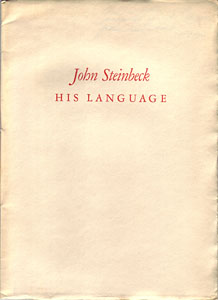
|
|
